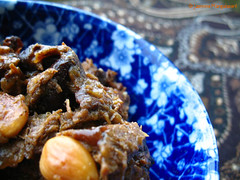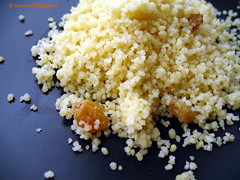 Tag-ine. You’re it.
Tag-ine. You’re it.Sorry. I couldn’t resist.
There was one rule for the potluck: bring something from a cuisine from which you normally don’t eat. Okay. There were two: list the ingredients beside the dish.
I suppose the challenge was easier said than done.
In the week prior to the lunch, I’d already partaken in Scandinavian, Italian, French, Mexican, Southern US, Thai and Vietnamese, along with the ubiquitous “Canadian” fare (foods that if I thought over long and hard I could ascribe to a region, but really: when you’re at the point of gnawing off your own leg, as long as the meal’s ready, edible and within reach, do you really want undertake a genealogical search on what you’re about to put in your mouth?).
Instead of challenging myself to a cuisine, I decided to revisit an underused-in-my-kitchen ingredient, and from that find some sort of national or cultural theme.
I’m not sure why I settled on lamb. As an unashamed carnivore who doesn’t practise ageism (apart from best before dates), I’m fully aware of the controversy of such a choice for a communal meal. But at the same time, it is a favoured meat in so many parts of the world. With so many options that lay before me—Chinese, Indian, the swath of Arabic-speaking nations, countries that lie on the Mediterranean’s northern shore—I decided to throw caution to the wind and simply cook.
Thanks to the genius that is Claudia Roden, I quickly became fixated on Morocco. I’d spent a day in Tangiers two lifetimes ago and fell in love with it as only a 16 year old school girl could. In Arabesque, I found two dishes that immediately leapt to the head of the queue Tagine Bil Barkok Wal Loz and Keskou Tfaya—Tagine of Lamb with Prunes and Almonds and Couscous with Lamb, Onions and Raisins.
Flicking between the two recipes, I quickly realised they could easily be combined into one. The prunes and almonds would be kept along with the couscous and honeyed caramelised onions. The couscous Claudia calls for is plain, but mine is usually made with stock, whole spices and raisins. A happy marriage of her two dishes, I think.
Moroccan stews or “tagines,” borrow their name from shallow round clay cooking pots with conical lids. If you don’t have the eponymous cooking vessel, you can simply use an aptly-sized lidded pot. Sweet and hearty, tagines of lamb and prune are the most well-known fruit tagines outside of Morocco, and often served with couscous and hot, buttered chickpeas.
 Lamb, Prune and Almond Tagine with Honeyed Caramelized Onions
Lamb, Prune and Almond Tagine with Honeyed Caramelized OnionsServes 8
5-6 onions (approx 1.25kg (2.75lbs)),
Flavourless oil
2 garlic cloves, minced
1tsp ground ginger
4 whole cloves, bashed lightly
3Tbsp ground cinnamon, divided
1kg (2lbs) boned lamb shoulder, trimmed of excess fat and cut into 2.5 cm (1”) chunks
Copious amounts of black pepper (start with 3Tbsp)
Salt
Water (approx 1.25L (5c))
400g (14oz) moist pitted prunes
A good, solid pinch of saffron threads (about 0.5tsp)
40g (3Tbsp) butter
1Tbsp olive oil
2Tbsp runny honey
100g (3.5oz) blanched whole almonds
3-4 drops sesame seed oil
Finely chop one of the onions and tip into a large heavy-bottomed pot with four tablespoons oil, garlic, half the ginger, cloves and one teaspoon cinnamon. Cook until the onions begin to turn translucent. Add the meat and brown on all sides. Cover with water, add about two tablespoons of pepper and a few heavy pinches of salt. Bring the pot to a boil and then reduce the flame and leave the meat to quietly simmer for about 1.5-2hrs.
Meanwhile, prepare the caramelised onions. Thinly slice the remaining onions into lunettes, place in a wide, shallow pan with 250ml (1c) water. Cover and cook over a low flame for about half an hour. Unlid, turn up the heat and continue cooking until all the liquid has evaporated. Add the butter, olive oil and stir until the onions caramelise to a warm, deep brown. Mix in the honey, one rounded teaspoon of cinnamon and a good pinch of salt.
Toast the almonds in a few drops of oil until golden. If you wish, you can roughly chop about half the nuts, or leave them whole.
The lamb is ready when it is tender and can be easily pulled apart with your fingers. When so, give the pot a stir (you can remove any scum that's floated to the top, if you wish, but it's not necessary) and add the prunes, remaining cinnamon, saffron, another teaspoon or two of pepper, the caramelised onions and stir again. Let simmer and thicken for 30 minutes.
Taste the thickened tagine and balance flavours to taste. Stir in the almonds and a few drops of sesame oil.
Note: Beef can be substituted for lamb.
Couscous is semolina made from ground hard durum wheat which is then sprinkled with water and then rolled in flour, and is Morocco’s national dish. The couscous found in Western markets is the pre-cooked, instant variety that requires some boiling water and a relatively short steaming time. Properly cooked, couscous is light and fluffy and can be served with meat or vegetable dishes, or can be sweetened and used in desserts.
 Couscous
CouscousServes 8
500g (3c) couscous
Pepper
Salt
A couple of handfuls of sultana raisins
5cm (2-inch) cinnamon stick
4-6 cardamom pods, lightly crushed
600ml (approx 2.5c) vegetable broth, off the boil
2Tbsp flavourless oil
A couple of teaspoons of butter (optional)
Mix the couscous, raisins and spices together and then pour the hot broth over the grains. Mix well. Cover the bowl with cling film, a lid or simply put a dinner plate over top. Let the grains swell for 10 minutes.
Mix in the oil. Rub the couscous between your hands, above the bowl, letting the grains separate and tumble back to the bowl, breaking up any lumps.
Preheat the oven to 200C/400F.
Tip the couscous into an ovenproof dish and pop it into the oven for about 15 minutes (or until it begins to steam). Before serving you can, if you wish, stir in the butter, as you fluff the grains with a fork.
cheers!
jasmine
I'm a quill for hire!

I love Claudia Roden's recipes! And middle eastern food. This is a great dish that you have created. The complex flavor basically emanates from the photo.
ReplyDeleteI'm hosting a blog event called regional recipes this month and the theme is Middle Eastern food. This would be perfect for it! You should consider submitting it :)
This sounds really good! I like the sweet and savoury combinations in tagines.
ReplyDeletefound your blog and love cardamon so had to look..yummies the couscous with raisins..added tiny slives of carrots and some italian parsley for some added color..used as a side with fish..was delish..thanks..
ReplyDeleteJoanne convinced me with her intro that must hop here,mnow i know why...what a deliciously flavoured lamb u have here...and sweet blog too...now that i said hi to u ,am going to walk around!!!1
ReplyDelete